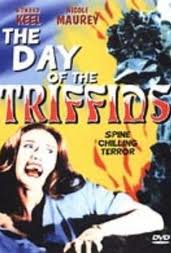
THE DAY OF THE TRIFFIDS
UK, 1962, 94 Minutes. Colour.
Howard Keel, Nicole Maurey, Janette Scott, Kieron Moore, Mervyn Johns.
Directed by Steve Sekely.
The Day of the Triffids is an adaptation of John Wyndham's famous novel. Enthusiasts for Wyndham's work were very disappointed in this film version. It was made in colour and in wide screen. The screenplay and adaptation was by Phillip Yordan, a very competent writer of many screenplays. However, the direction is uneven, the product an international adventure with a strange cast led by Howard Keel. There are many interesting special effects and trick camera work. The essence of Wyndham's science fiction is there. However, it is definitely only a version of the original. It was made in the early 60s, just before the enthusiasms for science fiction was to move into big budget films.
1. How good was this as science-fiction, how enjoyable?
2. Why do audiences enjoy science-fiction: futuristic, comment on society, comment in pessimistic terms on science and its effects on the world etc.? what insight into contemporary living is given by science-fiction?
3. The film's use of colour, widescreen, European locations, musical commentary?
4. Comment on the horror emphasis of the film in contrast with John Wyndham's comment on civilizations? Did the film incorporate the author's comments?
5. The film's focus on mason? The audience seeing the crisis through his eyes? How sympathetic and interesting a character was he? How heroic a figure for this film?
6. Did the film create a plausible atmosphere for the science-fiction happenings? The plausibility at the beginning, the change when the crisis occurred?
7. The impact of the meteorites and their visualization? The effect on the earth? How credible?
8. The visualizing of the Triffids: as filmed, creating fear, destructive, unexplained evil, human powerlessness in the face of them?
9. The importance of the various European locations: beginning in England, London, and the railway station etc., Paris and the same crisis, the house in France, Spain and the attack, the submarine setting, the Goodwins and their experimentation? Did this give an overall picture of the world under attack by the Triffids?
10. The importance of the 'chase' structure of the film? Masen escaping from a pursuing evil? The importance of Susan being with him, human interest and sympathy? Christine? The Spanish couple and the pregnant wife? Audience sympathy for these characters as victims? The contrast with the menace of the Triffids?
11. The contrast of the sequences with the Goodwins? The atmosphere of suspense and excitement? The need for them to find a remedy for the Triffids? The importance of their discovery?
12. How visually interesting and effective were such sequences as the attack on the house, the electric attack on the Triffids, the final water remedy?
13. The film's atmosphere of relief when the danger was warded off?
14. How good a standard of science-fiction was this film?